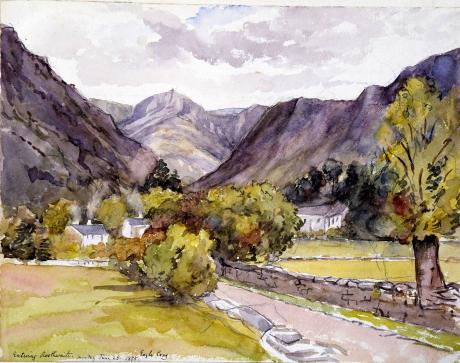inscribed and dated "Eagle Crag from Rosthwaite Monday June 28 1875" and signed with initials "LWT"
Tom and Laura Taylor and thence by descent
Eagle Crag is a fell in the Lake District in Cumbria, England, it is situated near the village of Stonethwaite where the valleys of Langstrath and Greenup join. Impressive walls of crag look down upon Stonethwaite, making Eagle Crag the most arresting sight from that settlement. It can be climbed direct by the average walker, picking a route between the rock faces.
The fell has not been given an official height by the Ordnance Survey and is given various heights by several other sources ranging between 520 and 525 metres. Bill Birkett gives the fell a height of 521 metres (1,709 feet) in his Complete Lakeland Fells. Alfred Wainwright gave the height at 1,650 feet (500 metres) approx in his Pictorial Guides to the Lakeland Fells in 1958, in which he writes:
Eagle Crag is so splendidly situated, so nobly proportioned and of so arresting appearance that it is a far worthier object than the parent fell (High Raise) rising behind.
Eagle Crag is part of the craggy termination of the northern ridge of the higher fell of High Raise and it presents a spectacular sight when viewed from the Stonethwaite valley. It is linked to Sergeant's Crag which is just under a kilometre away to the south by a ridge along which runs a dry stone wall which acts as navigation guide for walkers between the two tops.
The summit area is formed of the welded rhyolitic lapilli-tuff, tuff and breccia of the Crinkle Member. Patches of rhyolite outcrop lower down the slope.
A small cairn marks the summit, balanced on a tilted slab of rock, with crags a few yards distant to west and north. A corner in the dry stone wall is a couple of minutes walk away southward. The view from the top of the fell is best to the north and west with Borrowdale and the Langstrath valley and the fells around them being well seen.
Eagle Crag is usually climbed from Stonethwaite; it can be combined with the higher fells of High Raise and Ullscarf as well as the nearby Sergeant's Crag. A direct ascent of the fell seems to be impossible when it is viewed from the Stonethwaite valley, with vertical walls of crags seemingly barring the way. However, a route can be found through the crags to attain the summit directly. Descents by this route are not recommended because of the dangerous crags which cannot be seen from above. An easier ascent follows the bridleway up Greenup Gill; this well-blazed trail is part of Wainwright's Coast to Coast Walk. The route leaves the bridleway at height of 330 metres and attains the fell by cutting back on itself and climbing steep grassy slopes to the summit.
The crags directly beneath the summit are used by rock climbers with climbs graded in the extreme and very severe categories.
Rosthwaite is a settlement in the Borrowdale parish of Cumberland, Cumbria, England. It is also in Borrowdale in the English Lake District to the south of Derwent Water. The B5289 road goes through the settlement and it is to the east of the Honister Pass.
Historically part of Cumberland, the nearest town to Rosthwaite is Keswick, which is situated approximately 6 miles (9.7 km) to the north.
Rosthwaite is host to many interesting post-glacial geographical features. The town nestles underneath the How, a large roche moutonnée, with a smaller roche moutonnée being further to the west.
Near to and within Rosthwaite is also a set of terminal moraines which show the staggered retreat of the Stonethwaite Glacier. These are quite obvious, with the middle and best preserved moraine being found NY 258145.
Laura Wilson Barker (6 March 1819 – 22 May 1905), was a composer, performer and artist, sometimes also referred to as Laura Barker, Laura W Taylor or "Mrs Tom Taylor".
She was born in Thirkleby, North Yorkshire, third daughter of a clergyman, the Rev. Thomas Barker. She studied privately with Cipriani Potter and became an accomplished pianist and violinist. As a young girl Barker performed with both Louis Spohr and Paganini. She began composing in the mid-1830s - her Seven Romances for voice and guitar were published in 1837. From around 1843 until 1855 she taught music at York School for the Blind. During this period some of her compositions - including a symphony in manuscript, on 19 April 1845 - were performed at York Choral Society concerts.
On 19 June 1855 she married the English dramatist, critic, biographer, public servant, and editor of Punch magazine Tom Taylor. Barker contributed music to at least one of her husband's plays, an overture and entr'acte to Joan of Arc (1871), and provided harmonisations as an appendix to his translation of Ballads and Songs of Brittany (1865).
Her other works include the cantata Enone (1850), the violin sonata A Country Walk (1860), theatre music for As You Like It, (April 1880), Songs of Youth (1884), string quartets, madrigals and solo songs. Her choral setting of Keats's A Prophecy, composed in 1850, was performed for the first time 49 years later at the Hovingham Festival in 1899. The composer was present.
Several of Barker's paintings hang at Smallhythe Place in Kent, Ellen Terry's house.
Barker lived with her husband and family at 84 Lavender Sweep, Battersea. There were two children: the artist John Wycliffe Taylor (1859–1925), and Laura Lucy Arnold Taylor (1863–1940). The Sunday musical soirees at the house attracted many well-known attendees, including Lewis Carroll, Charles Dickens, Henry Irving, Charles Reade, Alfred Tennyson, Ellen Terry and William Makepeace Thackeray.
Tom Taylor died suddenly at his home in 1880 at the age of 62. After his death, his widow retired to Porch House, Coleshill in Buckinghamshire, where she died on 22 May 1905, aged 86.

